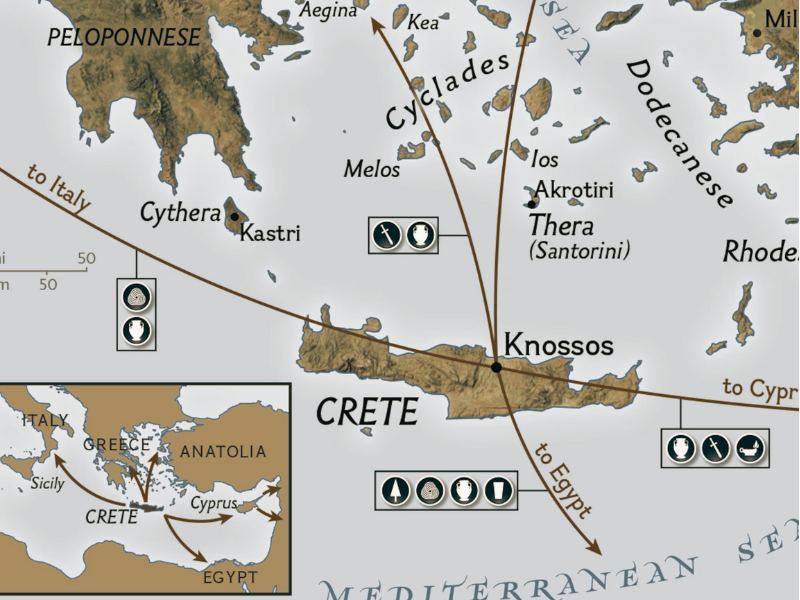Table of Contents
Introduction:
In the shimmering waters of the Aegean Sea, the Minoans, the first advanced civilization in Europe, embarked on an ambitious journey that would etch their name into the annals of history. Known for their vibrant palaces and cultural richness, the Minoans were also masters of the seas.
This maritime prowess, termed ‘Thalassocracy,’ was the cornerstone of their dominance in the ancient world. Nestled on the island of Crete, the Minoans used their strategic position and seafaring skills to weave a tapestry of trade networks and cultural influences across the Mediterranean.
The Foundations of Minoan Maritime Power:
The rise of Minoan thalassocracy was rooted in the early Bronze Age, a period marked by significant advancements in navigation and shipbuilding. Crete’s central location in the Aegean Sea served as a natural crossroads for maritime trade routes.
Archaeological discoveries, including sophisticated harbors and remnants of ships, reveal the early Minoan inclination towards seafaring. These initial steps laid the groundwork for a maritime empire that would dominate the region for centuries.

Minoan Naval Technology and Shipbuilding:
Minoan shipbuilders were renowned for their ingenuity and skill. Their vessels, sleek and swift, were designed for long voyages and substantial cargo. The remains of these ships, depicted in vivid frescoes such as those found in the ancient city of Akrotiri, showcase their advanced design, featuring large sails and sturdy hulls.
These maritime innovations not only enabled efficient travel across the Mediterranean but also bolstered their military might, protecting Minoan interests from external threats.
Control of Aegean Trade Routes:
At the heart of Minoan thalassocracy was their control over crucial Aegean trade routes. By dominating these sea paths, the Minoans facilitated the exchange of a myriad of goods, ranging from local Cretan products like olive oil and wine to exotic imports such as spices, metals, and luxury items. This extensive trade network was instrumental in the economic flourishing of Minoan society, bringing wealth and prosperity to the island.
Minoan Outposts and Influence:
The Minoans established strategic outposts across the Aegean and Mediterranean, extending their influence far beyond Crete. Key among these was the emporion on Cythera, an island serving as a vital trade link between Crete, the Peloponnese, and the broader Mediterranean.
By around 1925 BC, Minoans had established this base, not for territorial conquest but as a pivotal node in their trading network. This outpost managed the flow of goods like Minoan pottery from Kydonia, fine pottery from mainland Greece, and facilitated the processing and trade of valuable resources like Tyrian purple.
Cultural Impact of Minoan Thalassocracy:
The far-reaching trade routes of the Minoans facilitated not just the exchange of goods but also of ideas and culture. Artistic styles, religious practices, and technological knowledge flowed through these maritime connections. For instance, the influence of Minoan art and pottery was evident in the goods traded and the cultural imprints left in regions like Ugarit, an important city along the Syrian-Palestinian coast. Ugarit was a cosmopolitan hub where Minoan traders mingled with those from Mesopotamia, Egypt, and beyond, creating a melting pot of cultural exchange.
Decline and Legacy:
Despite their dominance, the Minoan thalassocracy eventually waned, a decline that can be attributed to a combination of natural disasters (like the eruption of Thera), and the rise of competing powers such as the Mycenaeans. The legacy of the Minoans, however, lived on. Their influence on maritime trade, shipbuilding, and cross-cultural exchange left an indelible mark on the Mediterranean world. The intricate network of trade routes they pioneered set the stage for future civilizations to thrive in this region.
Conclusion:
The Minoan thalassocracy stands as a testament to the ingenuity and ambition of an ancient civilization that mastered the art of maritime trade. From their strategic position in the Aegean, the Minoans wove a complex tapestry of trade routes that stretched across the Mediterranean.
Their legacy, etched in the ruins of their palaces and the remnants of their trade outposts, continues to inspire awe and wonder. The Minoan thalassocracy was not just a display of maritime might; it was a crucible of cultural exchange that shaped the course of ancient history.


